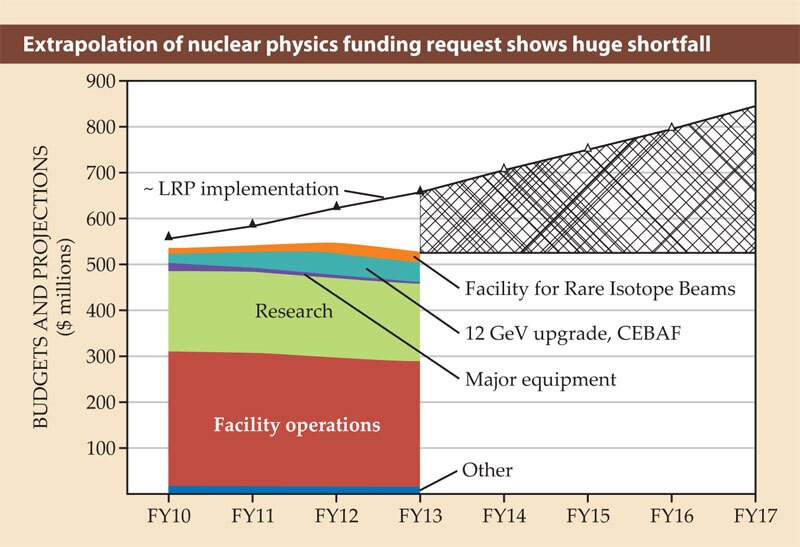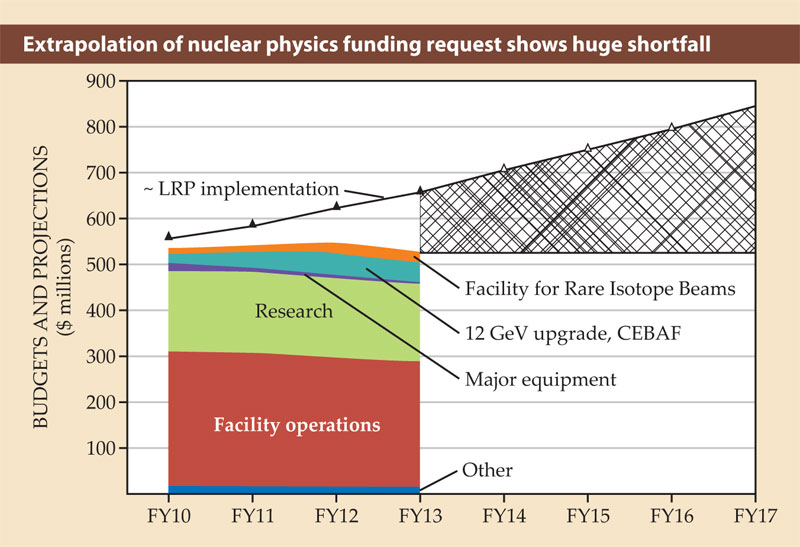US nuclear physics facilities on the chopping block
DOI: 10.1063/PT.3.1783
The US government’s pockets for nuclear physics have holes in them, requiring a hard look at what can—and can’t—go ahead under new funding constraints. A panel charged with that tough task has until 7 January 2013 to formulate recommendations for the Nuclear Science Advisory Committee (NSAC), a body that advises the Department of Energy and NSF.
At least one of the country’s three major nuclear physics facilities faces closure. The options would be to shut down either the Relativistic Heavy Ion Collider (RHIC) at Brookhaven National Laboratory or the Continuous Electron Beam Accelerator Facility (CEBAF) at Thomas Jefferson National Accelerator Facility, or to postpone construction of the Facility for Rare Isotope Beams at Michigan State University. “And if you postpone FRIB, you probably don’t build it,” says panel chair Robert Tribble of Texas A&M University.
The financial squeeze comes at what NSAC chair Donald Geesaman calls an “incredibly exciting time” scientifically for the field. “Nuclear physics has several areas of burning questions.” None of the facilities can address all of them, he says. “They are in very different energy scales.”
“Get the mule’s attention”
Only when President Obama’s proposed budget for fiscal year 2013 came out early this year did it become clear that nuclear physics is in trouble. When the community put together its most recent long-range plan (LRP) in 2007, physical sciences were on a track to double funding over a decade. Deviations from that doubling have been apparent in the past couple of years, but they were masked by stimulus money from the 2009 American Recovery and Reinvestment Act. The current request for the field is about $527 million, down 3.7% from FY 2012 (see Physics Today, April 2012, page 33
Many nuclear physicists say the reduction in the budget request came as a surprise. Adding to their puzzlement is that the budget request for DOE’s Office of Science is up but within the office, nuclear and high-energy physics and fusion-energy sciences are down, while basic energy sciences, advanced computing, and biological and environmental research are up. Brookhaven National Laboratory associate director Steven Vigdor says he read the proposed budget “as a two-by-four to get the mule’s attention—to get the nuclear physics community to deal with the problem.”
NSAC has charged the panel with considering two scenarios: flat funding starting in FY 2013, and an unspecified “modest” increase. Under flat funding, the LRP would fall short about $900 million over five years (see the figure on page 26).

If nuclear physics funding stays flat over the next five years, the field will have a cumulative shortfall of around $900 million (hatched area) for implementing its 2007 long-range plan (LRP). Ongoing costs for the Continuous Electron Beam Accelerator Facility (CEBAF) and the Relativistic Heavy Ion Collider are included in the facility operations band. (Data from the Department of Energy and Robert Tribble.)

Hard choices
Shutting CEBAF seems farfetched. As one FRIB scientist puts it, “Jefferson Lab would be the most imprudent to nix. They have invested a huge amount, and I think the science community doesn’t nix something that is just about built.” A $310 million upgrade to increase the beam energy from 6 GeV to 12 GeV took the top spot in the LRP. That upgrade, now about 70% done, will open new possibilities for exploring the structure and interactions of quarks and gluons inside hadrons and nuclei, studying the nature of quark confinement, and performing precision tests of the standard model of particle physics. The facility is widely recognized as unique in terms of its energy range and purpose. And although some pieces of the science might get picked up by Japan’s J-PARC or other hadron facilities, most would be lost.
The LRP’s second priority was FRIB. Based on a superconducting linear accelerator, FRIB will be able to make thousands of different isotopes, including many unstable ones that have never been produced in usable quantities (see Physics Today, February 2009, page 25
A site at Michigan State University is ready for FRIB, and the university and state are jointly paying $94 million of the facility’s $680 million tab. A handful of rare-isotope facilities are in the works around the world, but FRIB—designed to be 1000 times more powerful than its predecessor, the National Superconducting Cyclotron Laboratory—would produce the highest intensity and broadest range of isotopes.
To many, RHIC looks to be the most likely victim. The perception of dispensability comes from the sense that RHIC, where the first quark–gluon plasmas were created in 2005, has seen its heyday, and that the Large Hadron Collider at CERN can pick up the slack in studying the new high-density, high-temperature state of matter and in gaining insights into the early universe. “People often miss that quark–gluon studies at the LHC and RHIC are complementary,” Vigdor says. “The crucial transition from ordinary nuclear matter to quark–gluon matter appears to occur within the RHIC energy range, far below LHC’s reach.” It doesn’t help that of the three major facilities, RHIC has the highest annual running cost: $160 million, compared with roughly $105 million for CEBAF and $65 million for FRIB. Increasing the luminosity by an order of magnitude at RHIC was the fourth priority in the LRP. Technical advances slashed the tab from $95 million to $10 million and the upgrade was completed earlier this year.
Besides the science to be done at CEBAF, FRIB, and RHIC, nuclear physics encompasses studies related to neutrinos and the standard model. But cutting such studies, which were in the third spot in the LRP, or slashing the various nuclear physics efforts at universities, would not add up to enough to accommodate the expected decrease in funding.
Flat budget, slippery slope
Nuclear physics has a long-term payoff, says Norm Augustine, chair of the National Academy of Sciences (NAS) committee that put out the Rising Above the Gathering Storm report, which sounded alarms that the US was not investing enough in education and research (see Physics Today, December 2005, page 25
If the budget stays flat, says Tribble, “something has to give. And any of the options will put a huge hole in the field.” In fact, he says, “the damage to US leadership and credibility could lead to a downward spiral that could mean the difference between having a vibrant nuclear physics program in the long run and maybe not.”
If the government doesn’t invest in nuclear physics, then universities won’t either, Tribble explains. And with a lot of faculty close to retirement, “it’s a critical time for reinvestment.” Tribble worries that the US is headed down the same slippery slope as the UK, the Netherlands, and Belgium. “The UK really lost their leadership role big time,” he says. “It started 15 years ago with the closure of their last major facility.”
In forming recommendations about what to axe, says Tribble, “ultimately, we have to look ahead to see what is the best option under constrained conditions. We have to look at the science we can do in each area. Then it becomes a bit subjective. We have to see where we want to be in a decade.” Vigdor notes that the community has been good at “avoiding internal nastiness. We have a strong tradition of balancing different subfields. I think everyone is working hard to avoid blood-letting.”
More about the Authors
Toni Feder. tfeder@aip.org
